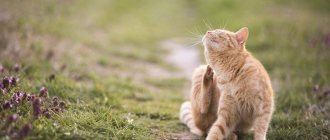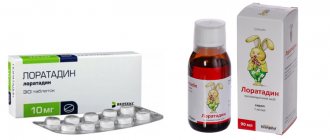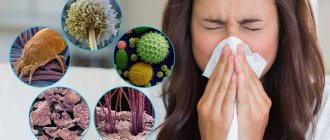Types of allergens
Antipollin is the name of the brand of the drug. Under this “name” many drugs are produced, both monoallergens and mixed ones:
Photo: Appearance of packaging and blister
- Antipolline mix of birch, alder, hazel, hornbeam;
- Antipolline trees: poplar, elm, maple, birch, oak;
- Antipolline weeds 1: cocksfoot, fescue, wheatgrass, timothy, ryegrass;
- Antipolline weeds 2: quinoa, ragweed, wormwood, sunflower;
- Antipolline wormwood – a mix of bitter, annual, common wormwood and tarragon;
- Antipolline mites;
- Antipollin house dust;
- Antipolline birch, as well as allergens of poplar, timothy, hedgehog, rygas, fescue, ragweed, hemp, quinoa - each separately.
Instructions for use of allergens Antipollin
All of the listed types of allergens have general rules of use, contraindications and side effects. An allergist should tell you in detail how to use Antipollin; in fact, only he has the right to prescribe this medicine.
Recent studies have shown that sublingual administration has a greater effect, since the allergen comes into contact with the pharyngeal lymphatic ring (tonsils), as well as the lymph nodes of the esophagus, which increases the effectiveness of treatment.
Indications
Any manifestations of seasonal hay fever - urticaria, rhinitis, conjunctivitis, bronchitis, dermatitis.
Typically, ASIT is prescribed when there is no particular effect from antihistamines, and the symptoms significantly disrupt the allergy sufferer’s usual way of life.
ASIT is most often used in children, since the risk of hay fever developing into bronchial asthma is extremely high.
Contraindications and side effects
The instructions for use offer the following list of conditions for which immunotherapy is prohibited:

Positive review about Antipolline: the drug really alleviates the course of the disease (author: AliaUU source: irecommend.ru)
- children under five years of age and elderly people over 66 years of age;
- period of exacerbation of allergies;
- pregnancy and breastfeeding;
- severe pathology of internal organs;
- serious chronic diseases caused by infectious agents (for example, tuberculosis of any form);
- endocrine pathology;
- connective tissue pathology;
- oncopathology;
- HIV+;
- mental illnesses.
Adverse events occur only if the technology or frequency of administration, dose is violated, or treatment is continued in a situation where it should not have been continued. These include:
- exacerbation of any allergic disease;
- manifestations of oral allergic syndrome - itching in the mouth, swelling of the mucous membrane, burning sensation;
- anaphylactic shock or Quincke's edema (extremely rare).
Admission procedure
As already mentioned, you should start taking the pills 2-2.5 months before the start of the allergy season
- Blister tablets from 1 to 5 – initial course – every day,
- From 6 to 7 – main course – taken daily,
- 8 (main course) and 9 (maintenance course) blisters - every other day.
Take it in the morning, 30 minutes before meals, without drinking water. The tablet must be placed under the tongue and kept there until completely dissolved. After taking it, it is not recommended to smoke for half an hour.
Use for sensitivity to multiple allergens
It is worth noting that, in the presence of polysensitization, it is permissible to prescribe two drugs at once.
In this case, one drug is taken in the morning, and the second in the evening (preferably at the same time).
While taking the drug, you should not drink alcohol, take glucocorticosteroids, or non-steroidal anti-inflammatory drugs.
If, after dissolving the tablet, intense itching appears in the mouth, the mucous membrane is swollen, a sore throat, coughing and choking appear, you should urgently take an antihistamine and consult a doctor.
In this case, the course of treatment will need to be adjusted, up to and including its complete cancellation. It is necessary to stop ASIT for the period of acute illness (whether acute respiratory infection, rotavirus infection or food poisoning). If pregnancy occurs during the course of treatment, it is necessary to discuss the possibility of continuing it with an allergist.
Antipollin against allergies
If an allergy appears in the body, the disease is chronic, i.e. will remind you of itself more than once with an unpleasant attack. To reduce the number of relapses and the severity of symptoms, it is recommended to take the drug Antipollin, which has stable antihistamine properties.
General description and instructions for use of the drug Antipollin
In fact, these are tableted allergens, the main task of which, upon penetration into the body, is to develop specific antibodies and increase resistance to factors that provoke the disease.
The drug Antipollin contains 20 pollen allergens at once, and this unique complex was developed back in 2002 in Kazakhstan by academician V.S. Moshkevich.
Since then, the medicine has undergone numerous clinical trials, has gone on sale, and is very popular among chronic allergy sufferers.
The medical drug Antipollin has several compositions, and the chemical formula of each variety contains its own mix. This is a mixture of potential allergens, and the doctor’s task is to determine in which clinical picture which Antipollin is more suitable to ensure a sustainable therapeutic effect. Below are all existing types of this antihistamine. So:
- mixed tree, especially relevant for the classic form of allergy to poplar fluff and pedunculate oak;
- mixed meadow grass, which is recommended for acute allergic reactions to creeping wheatgrass and meadow fescue;
- mixed weed, which is prescribed for allergies to wormwood, ragweed, quinoa and tumbleweed;
- mixed house dust, which collects all possible allergens of domestic origin, including mold fungi and pet hair;
- Mixed wormwood protects against allergies when the weed of the same name with a specific aroma grows.
Having determined the nature of the pathology, the doctor recommends taking a course of the drug Antipollin, taking into account the specifics of the allergen and the actual state of health. According to clinical studies, stable positive dynamics are observed in 80% of all clinical pictures. This is a good indicator, especially since one should take into account the constantly growing number of newly arrived allergy sufferers.
The principle of action and the main advantages of the drug Antipollin
Since a large concentration of harmful allergens enters the body along with the specified antihistamine, the body develops increased resistance to such provoking factors.
This effect allows you to develop a long period of remission and forget about seasonal and year-round exacerbations.
When real “provocateurs” penetrate the body from the outside, it steadfastly resists them and reduces the intensity of unpleasant symptoms.
In order for the disease to recede for a long time, you need to complete the full course, and, if necessary, repeat it after 3-5 months. To understand the high effectiveness of Antipollin, it is necessary to focus on its main advantages:
- painless and safe use;
- high efficiency of intensive therapy at home;
- affordable cost of medication;
- one package of medicine – a full course;
- a unique opportunity to replace a complex of antihistamines with one medication.
Instructions for use
This medication, when all medical recommendations are followed, is well tolerated and adapts imperceptibly in the body. If you do not follow the instructions and systematically increase the daily dose, doctors list swelling of the mucous membrane and itching in the oral cavity as complications. In addition, exacerbation of other diseases, also of allergic origin, is possible.
Antipollin is intended for oral administration and is available in the form of tablets that are supposed to be dissolved until completely dissolved.
It is required to start treatment with a minimum dose of the allergen, but gradually increase it to the maximum permissible concentration of 1000 PNU.
The duration of such therapy is 2 months, and it is better to check the detailed regimen for taking antihistamines individually with an allergist.
If the dynamics are positive, repeat the Antipollin treatment course after 2 months, while not forgetting about drug interactions. This medication has no complete analogues, and its pharmacological effect in the body is considered unique. The medication is prescribed in the absence of medical contraindications, which are the following clinical pictures:
- cardiovascular diseases;
- tuberculosis;
- immunodeficiency states;
- autoimmune pathologies;
- damage to the endocrine system;
- mental disorders;
- periods of pregnancy and lactation.
Reviews about the drug Antipollin
This medication is well known to chronic allergy sufferers, as well as patients at risk. However, not everyone is ready to accept it. They explain this by their fear of deliberately releasing allergens into the blood.
In fact, this is an erroneous opinion, since studies have confirmed the arrival of sustainable positive dynamics with the right choice of medicine. On medical forums you can find many notes in which people describe their internal fears and concerns.
If you consult a doctor in time, the specialist will definitely dispel all doubts.
There are patients who have used this prescription in practice and were satisfied with the results obtained. There is no doubt that Antipollin really works if the mix is chosen correctly. Otherwise, you can only increase the general intoxication of the body. This once again proves the need to consult with an allergist on a given topic.
To summarize, all that remains is to add that the Antipollin allergen complex is highly effective, since it successfully suppresses allergy attacks of various origins. Many patients have seen this personally; for others, doctors strongly recommend not to ignore this medical prescription.
Overall rating: 3.3 out of 5
Source: https://zhivizdorovim.ru/lekarstva/drugie-lekarstva/12097-antipollin.html
What do you need to know to purchase the drug?
First, of course, the price must be known. ASIT is not a budget treatment. For one course you will have to pay from 5500 to 7000 rubles. But often once is not enough, and the procedure has to be repeated a year later.
| Allergen | Price on the official website (with delivery in Moscow) | Cost in pharmacies |
| All allergens except mixed mites (supporting) and house dust (supporting) | 5900 rub. | 5500 – 7000 rub. |
| Mix of mites (supportive) and house dust (supportive) | 4250 rub. |
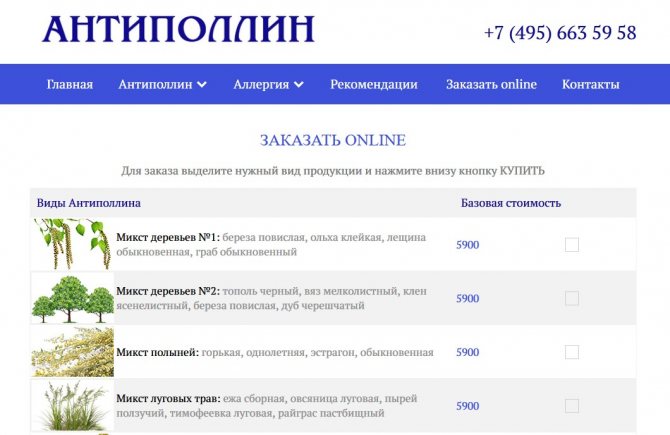
But “getting” the medicine is not very easy. You won’t be able to just go to a pharmacy and buy it (except in Moscow and St. Petersburg).
You can order the “vaccine” through the official website by going to the “Order online” section, as well as through pharmacy websites. However, it is worth noting that it is much easier to buy this medicine than, for example, its analogues Staloral or Fostal.
Read more information about possible places to purchase allergens for ASIT in the following article
Antipolline: Mixed trees No. 1, 2 and their analogues
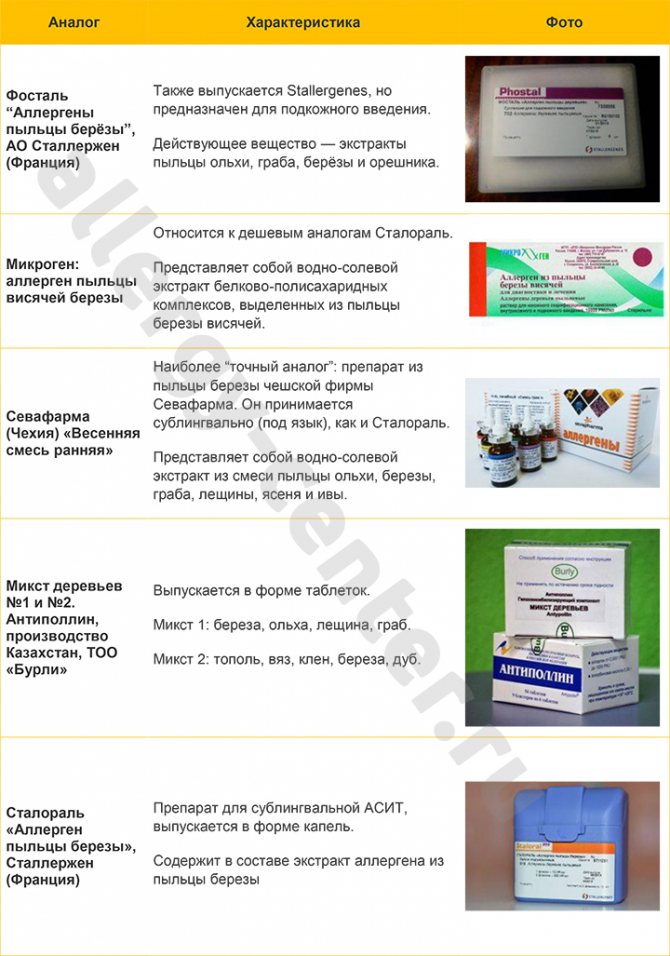
Antipollin: mixed ticks and its analogues
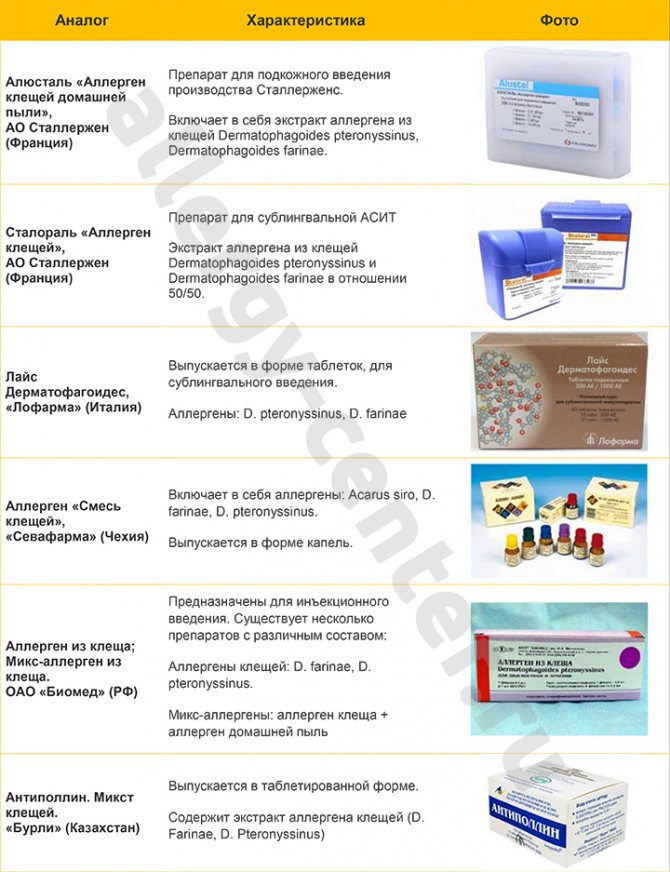
Prices for Antipollina analogues
There are both expensive and cheaper analogues of Antipollina. For example, allergens Fostal (for subcutaneous injections) are in a high price category, from 7,000 rubles. But the prices for Staloral are approximately at the same level, with the exception of the mite allergen, which costs 4,000 rubles.
The main difference lies in the method of administration of the drug.
Among the cheap analogues are allergens produced in Russia by NPO MicroGen . These are solutions for subcutaneous administration with absolutely the same idea - first small doses, then large ones. There is no evidence that the drugs are not effective or cause many side effects, although their cost ranges from 500 to 1000 rubles.
Antipolline wormwood
Lozenges
Compound
One tablet contains
active substance – allergen from wormwood pollen 0.0001 PNU – 1000* PNU**,
excipients: ascorbic acid, granulated sugar, talc.
*package No. 1 contains tablets with a dosage of 0.0001 PNU/tab, package No. 2 – 0.001 PNU/tab, No. 3 – 0.01 PNU/tab, No. 4 – 0.1 PNU/tab, No. 5 – 1 PNU/tab, No. 6 – 10 PNU/tab, No. 7 – 100 PNU/tab, No. 8 and No. 9 – 1000 PNU/tab.
** PNU is a unit of protein nitrogen; 1 PNU contains 0.00001 mg of protein nitrogen.
Description
Tablets are white, creamy, with a flat surface.
Pharmacotherapeutic group
Grass pollen allergens
ATS code V01AA02
Pharmacological properties
Antipolline wormwood has an immunotherapeutic effect, ensures the formation of stable immunity of the body to the allergic effects of wormwood pollen, by modifying the nature of the body's response to this type of allergen.
The exact mechanism of action of the allergen during subbucal specific immunotherapy is not completely clear. The active principle is a protein-polysaccharide complex that interacts with reagins (specific IgE antibodies) of patients, resulting in the formation of:
– specific antibodies (IgG4), playing the role of “blocking antibodies”;
– the level of specific IgE in plasma decreases for a long period;
– the reactivity of cells involved in the allergic reaction decreases;
– the activity of interaction between T-lymphocytes Th2 and Th1 and even Th0 increases, leading to a positive change in the production of cytokines (decrease in IL-4 and increase in γ-interferon) that regulate IgE production.
In addition, subbucal allergen-specific immunotherapy induces an immune response, which allows the maintenance of immunobiological memory for a long period.
The effectiveness of subbucal immunotherapy is higher in cases where treatment is started in the early stages of the disease.
Indications for use
– seasonal hay fever with clinical manifestations of allergic rhinitis, allergic conjunctivitis, urticaria, bronchial asthma, bronchitis in patients with hypersensitivity to wormwood pollen.
Directions for use and doses
Treatment is prescribed to each patient by an allergist at least 2 months before the wormwood begins to bloom.
Therapy begins with a minimum dose of allergen 10-8 (blister No. 1 - 0.0001 PNU), gradually increasing the dose 10-7, 10-6, 10-5, 10-4, 10-3, 10-2, 10-1 (blister No. 2 – 0.001 PNU, blister No. 3 – 0.01 PNU, blister No. 4 – 0.1 PNU, blister No. 5 – 1 PNU, blister No. 6 – 10 PNU, blister No. 7 – 100 PNU, blister No. 8 – 1000 PNU, blister No. 9 - 1000 PNU). The tablet is placed behind the cheek and held until completely absorbed.
The maximum daily dose of wormwood pollen allergen is 1000 PNU.
Treatment consists of three stages:
Initial therapy
Blister No. 1 (0.0001 PNU) – 1 tablet every day, for 6 days;
Blister No. 2 (0.001 PNU) – 1 tablet every day; within 6 days;
Blister No. 3 (0.01 PNU) – 1 tablet every day; within 6 days;
Blister No. 4 (0.1 PNU) – 1 tablet every day; within 6 days;
Blister No. 5 (1 PNU) – 1 tablet every day; within 6 days;
Basic therapy
Blister No. 6 (10 PNU) – 1 tablet every day; within 6 days;
Blister No. 7 (100 PNU) – 1 tablet every day; within 6 days;
Blister No. 8 (1000 PNU) – 1 tablet every other day; within 11 days;
Maintenance therapy
Blister No. 9 (1000 PNU) – 1 tablet every 1 or 2 days, for 11/16 days.
Depending on the patient’s condition while taking the pills, the allergist can adjust the treatment regimen.
It is recommended to take several off-season courses.
Side effects
Rarely
– local reactions: itching in the mouth, swelling, discomfort in the mouth and throat, disruption of the salivary glands (increased salivation or dry mouth);
Very rarely
– systemic reactions: exacerbation of the underlying disease (rhinitis, conjunctivitis, asthma, urticaria, bronchitis).
Contraindications
– children under 5 years of age
– patients over 60 years old
– exacerbation of hay fever
– severe bronchial asthma with reduced lung function (FEV1
Source: https://drugs.medelement.com/drug/%D0%B0%D0%BD%D1%82%D0%B8%D0%BF%D0%BE%D0%BB%D0%BB%D0%B8 %D0%BD-%D0%BF%D0%BE%D0%BB%D1%8B%D0%BD%D1%8C-%D0%B8%D0%BD%D1%81%D1%82%D1%80 %D1%83%D0%BA%D1%86%D0%B8%D1%8F/13842571477650934?instruction_lang=RU

